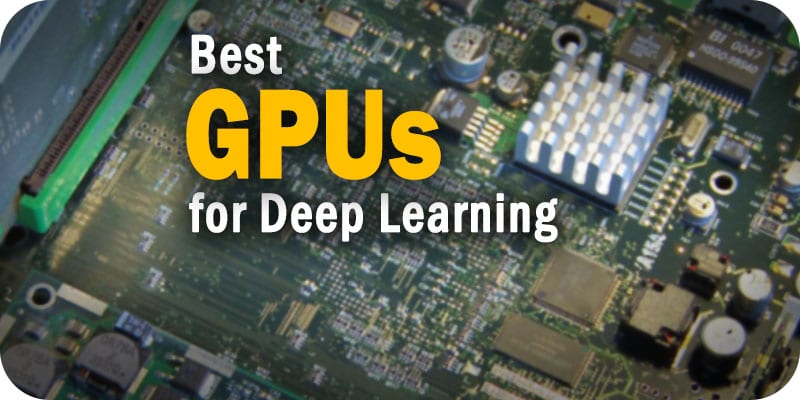The 5 Best GPUs for Deep Learning to Consider in 2023


The editors at Solutions Review have compiled this list of the best GPUs for deep learning based on advice from experts in the field.
 The best GPUs for deep learning and data science are becoming an increasingly vital hardware requirement as practitioners scale analytics and machine learning. The challenge of finding the right graphics processing unit for your use case can be difficult for this very reason. So project your current and future needs carefully because GPU selection will hinge mainly on your workload. You will also need to take into account that different products are better served for personal versus professional use.
The best GPUs for deep learning and data science are becoming an increasingly vital hardware requirement as practitioners scale analytics and machine learning. The challenge of finding the right graphics processing unit for your use case can be difficult for this very reason. So project your current and future needs carefully because GPU selection will hinge mainly on your workload. You will also need to take into account that different products are better served for personal versus professional use.
With these things in mind, our editors assembled this list of the best GPUs for deep learning based on expert advice from some of the top contributors on Quora. We also consulted A 2021-Ready Deep Learning Hardware Guide from the folks at Towards Data Science, which is another excellent resource. Each of the best GPUs for deep learning featured in this listing are featured under Amazon’s Computer Graphics Cards department. Only products with verified customer reviews are included.
Note: The best GPUs for Deep Learning are listed in order based on the total number of Amazon user reviews at the time of publication.
The Best GPUs for Deep Learning
SUMMARY: The NVIDIA Tesla K80 has been dubbed “the world’s most popular GPU” and delivers exceptional performance. The GPU is engineered to boost throughput in real-world applications while also saving data center energy compared to a CPU-only system. The increased throughput means improved performance. The K80 features 4992 NVIDIA CUDA cores with a dual-GPU design, 24GB of GDDR5 memory, 480 GB/s aggregate memory bandwidth, ECC protection for increased reliability and server-optimization.
- Supports DirectX 12
- Ideal for an array off AI use cases
- Proven, reliable performance
- No integrated fans
- Requires passive cooling
- Not ideal for very large workloads
OUR TAKE: The NVIDIA Tesla K80 combines two graphics processors to increase performance. Being a dual-slot card, the NVIDIA Tesla K80 draws power from a 1x 8-pin power connector, with power draw rated at 300 W maximum. This device has no display connectivity, as it is not designed to have monitors connected to it. Tesla K80 is connected to the rest of the system using a PCI-Express 3.0 x16 interface.
 NVIDIA GeForce GTX 1080 Ti
NVIDIA GeForce GTX 1080 TiSUMMARY: The NVIDIA GeForce GTX 1080 is powered by NVIDIA’s popular Pascal architecture and offers top-notch performance and power efficiency. According to NVIDIA, Pascal can deliver up to “3x the performance of previous-generation graphics cards, plus innovative new gaming technologies and breakthrough VR experiences.” The GTX 1080 also touts upgraded heat dissipation from previous generations, as well as a vapor chamber cooling technology. This GPU is made out of premium materials as well.
- Pascal architecture
- Upgraded heat dissipation
- Component protection system
- Unsecure fan cables
- Runs hot at factory settings
- Expensive for the functionality
OUR TAKE: The NVIDIA GeForce GTX 1080 supports DirectX 12 and features a large chip with a die area of 314 mm² and 7,200 million transistors. It offers major upgrades from its GeForce GTX 980 predecessor like a new architecture framework, double the frame buffer RAM, 30 percent faster memory speed, and more juice out of the boost clock. Display outputs include 1x DVI, 1x HDMI, 3x DisplayPort. GeForce GTX 1080 is connected to the rest of the system using a PCI-Express 3.0 x16 interface.
 GeForce RTX 2080 Founders Edition
GeForce RTX 2080 Founders EditionSUMMARY: The NVIDIA GeForce RTX 2080 is powered by NVIDIA’s next-generation Turing architecture which, according to the company “gives you up to 6X the performance of previous-generation graphics cards.” The Turning architecture brings AI-processing horsepower that hastens performance with NVIDIA DLSS 2.0. as well. Simultaneous floating-point and integer processing enables the GPU to more efficiently process and compute-heavy workloads.
- Turing architecture
- Factory overclocked
- DLSS 2.0 graphics
- Minor air exhausting issues
- Resolution output learning curve
- Value lacking compared to other NVIDIA GPUs
OUR TAKE: The Founders Edition of the NVIDIA GeForce RTX 2080 is factory overclocked and offers an 8-phase power supply for overclocking. It also boasts a dual-axel 13-blade fan coupled with a vapor chamber for cooler and quieter performance. Compared to the base model NVIDIA RTX 2080, this version offers small but notable improvements. NVIDIA has paired 8 GB GDDR6 memory with the GeForce RTX 2080, which are connected using a 256-bit memory interface. The GPU is operating at a frequency of 1515 MHz and can be boosted up to 1710 MHz.
 NVIDIA GeForce RTX 3060 XC
NVIDIA GeForce RTX 3060 XCSUMMARY: The NVIDIA GeForce RTX 3060 takes advantage of NVIDIA’s Ampere architecture, the company’s second-generation RTX framework. The GPU, according to the company, offers “Ray Tracing Cores and Tensor Cores, new streaming multiprocessors, and high-speed G6 memory.” The GeForce RTX 3060 also touts NVIDIA’s Deep Learning Super Sampling, an AI rendering that boosts frame rates with uncompromised image quality using a dedicated Tensor Core AI processing framework.
- Ampere architecture
- DLSS AI acceleration
- Great for modern use cases
- Some shading is disabled
- No DVI ports
- Current price point
OUR TAKE: The NVIDIA GeForce RTX 3060 is a premium GPU that supports DirectX 12 Ultimate. Unlike the fully unlocked GeForce RTX 3070, which uses the same GPU but has all 6144 shaders enabled, NVIDIA has disabled some shading units on the GeForce RTX 3060. The 3060 also includes 152 tensor cores which help to increase the speed of machine learning applications. The product has 38 raytracing acceleration cores as well. The card measures 242 mm in length, 112 mm in width, and features a dual-slot cooling solution.
 NVIDIA TITAN RTX
NVIDIA TITAN RTXSUMMARY: The NVIDIA Titan RTX is designed for researchers, developers and creators. The GPU is powered by NVIDIA’s Turning architecture and touts 130 Tensor TFLOPs of performance, 576 tensor cores, and 24GB of GDDR6 memory. The Titan RTX is supported by NVIDIA drivers and SDKs as well. According to NVIDIA, the Titan RTX works with “all popular deep learning frameworks and is compatible with NVIDIA GPU Cloud (NGC).”
- Turing architecture
- Designed for AI and machine learning
- Great for large models and neural networks
- Coil whine under heavy stress
- Additional cooling sometimes needed
- Use case dependant; compare to NVIDIA RTX 2080
OUR TAKE: The NVIDIA Titan RTX is a dual-slot card with a power draw rated at 280 maximum watts. Display outputs include 1x HDMI, 3x DisplayPort, 1x USB Type-C and is connected to the rest of the system using a PCI-Express 3.0 x16 interface. The DirectX 12 Ultimate capability ensures support for hardware-raytracing, variable-rate shading and more. The graphics processor is on the larger side.
NOW READ: The Best Data Analytics Laptops for Data Science
Solutions Review participates in affiliate programs. We may make a small commission from products purchased through this resource.































